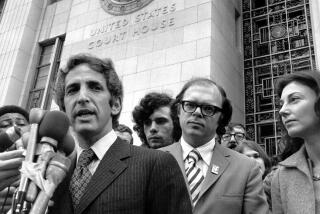Flight of Soviet Envoy Told at Arthur Walker Spy Trial
- Share via
NORFOLK, Va. — As soon as she entered the suburban Washington apartment of Aleksey G. Tkachenko last May 31, Joan Johnson knew her tenant, a Soviet diplomat, and his family had left in a rush--and without paying their last month’s rent.
They had left behind dirty pots and pans on the kitchen counter, rotting hamburger, milk and lunch meat in the refrigerator, pictures on the walls and furniture belonging to the Soviet Embassy, including a dresser-mirror combination adorned with a blue-and-white bumper sticker that read: “President Reagan--Bringing America Back.”
Prelude to October Trial
Johnson, resident manager of the Hamlet Apartments in Alexandria, Va., told her story in federal court Thursday as part of the government’s spy case against Arthur J. Walker, a trial that also has served as a prelude to the expected spectacular October spy trial of Walker’s younger brother, John, 47, a Norfolk private detective.
John A. Walker Jr. was arrested May 20 after purportedly trying to pass Navy secrets to Tkachenko, a vice consul at the Soviet Embassy who fled the country three days later.
The government rested its case against 50-year-old Arthur Walker after calling the last of 38 witnesses, many of them FBI agents who provided colorful details about the apprehension of John Walker and the flight of Tkachenko, as well as about Soviet espionage techniques, known as “trade craft.”
Meanwhile, U.S. District Judge J. Calvitt Clarke, who is presiding over the trial, set final arguments in the case for today after Walker’s attorneys refused to have the retired Navy lieutenant commander testify in his own defense or to call other witnesses.
In what appeared to be a serious blow to Walker, Clarke, who will decide the case, rejected defense motions to dismiss it or throw out much of the government evidence, including confessions Walker made in May to the FBI and a grand jury.
Walker is accused of stealing classified documents from a defense contractor he worked for and passing them to his brother, the alleged leader of a Soviet spy ring that also included John Walker’s son, Michael Lance, 22, a Navy seaman, and a close friend, Jerry A. Whitworth of Davis, Calif., both scheduled to face espionage charges.
FBI agents who were part of a surveillance team that tailed John Walker May 19 from Norfolk to suburban Washington testified that they twice spotted Tkachenko in his blue 1983 Chevrolet Malibu near the wooded area where Walker allegedly dropped off a grocery bag with 129 secret Navy documents hidden under garbage. The FBI retrieved the bag.
Agents said that they followed John Walker to a Ramada Inn in nearby Rockville, Md., where they confronted him at 3:45 a.m. as he approached the seventh-floor elevator lobby.
‘Drop the Weapon, FBI’
“I saw a manila envelope drop to the floor,” recalled agent James L. Kolouch, who said that John Walker then pulled a revolver. “We said, ‘Drop the weapon, FBI.’ It was not pointed directly at us. We repeated ourselves and he dropped his weapon.”
Kolouch said that he and other agents pushed John Walker against the wall, ripped off his toupee, emptied his pockets and stripped him of his belt and running shoes.
On May 23, FBI agents spotted Tkachenko at Washington’s National Airport along with his wife, Olga, and their daughters, Oksana and Mariya. Agent Stephanie P. Gleason testified that the family was accompanied from the ticket counter to the gate by three Soviet escorts. One of the escorts boarded a New York Air jet with them before returning to the lobby area. The family later left the country from New York.
Several hours after John Walker’s arrests, a squad of 25 to 30 investigators armed with a search warrant began scouring his Norfolk home, FBI agent Paul Galeydis testified. In a bookcase in the den, Galeydis said, he found photographs of areas in northern Virginia that were covered with unusual notes, arrows, instructions and sketches of intersections.
Among other material confiscated were part of a map of Vienna highlighted by dots and arrows and a letter in two colors of ink titled “the Vienna procedure.” Another letter contained headings such as “procedure for summoning me to make an exchange” and “procedure for a face-to-face meeting outside the country.”
Other agents testified that material found in the grocery bag as well as the manila envelope dropped by Walker contained detailed photographs and maps of the area to which he was followed May 19. The maps were illustrated by arrows and notations such as “My drop point” and “Your drop point,” and similar marks were made on the photos.
Gerald P. Richards, an FBI “trade craft” specialist, said that the material and their markings, as well as the elaborate methods they appeared to outline for setting up an exchange of secret documents, bore the trademark of a Soviet intelligence operation.
He said that the material he reviewed indicated an intricate plan in which an “asset,” the agent, and his “handler” were to leave a series of signals for each other, such as soda cans or orange peels to indicate their readiness to proceed with the mission. Richards said the Soviets prefer this “rigorous system” before an exchange so that they can observe the asset to see whether he is being followed.
“There’s no question in my mind that they are Soviet trade craft,” Richards said of the maps, photos and instruction letters recovered.
More to Read
Sign up for Essential California
The most important California stories and recommendations in your inbox every morning.
You may occasionally receive promotional content from the Los Angeles Times.












